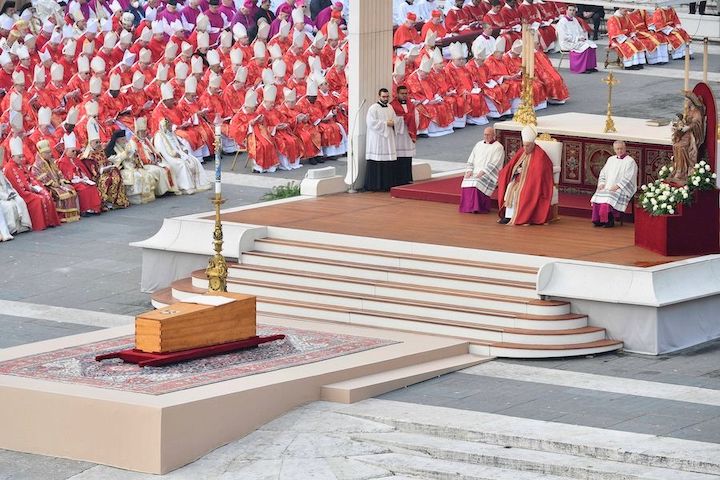Pope Francis’s brief homily at the funeral of Pope Benedict XVI produced something of a controversy. Critics complain that it was cramped and impersonal, devoid of any meaningful references to his predecessor. The one sentence in the final paragraph that explicitly mentioned Benedict could be spoken of virtually any Catholic.
In Francis’s defense, some commentators contend the homily was Christocentric, others have claimed that such a perspective would have tallied both with Benedict’s own theological focus and self-effacing humility. One defender added that “comparisons to 2005 [i.e., John Paul II’s funeral]. . .serve no purpose, as circumstances were different” because Benedict was not the incumbent pope. Others have pointed out that funeral homilies are not eulogies. So Francis’s approach was liturgically correct. Jesuit Cardinal Michael Czerny characterized the homily as pastoral, a “spiritual tribute,” explaining that a “eulogy or panegyric” belonged in “another time and place.”
And to what extent was it just the pope applying his “ten minutes or under rule” that homilies should be brief and to the point?
So, is there “any there there?” Is reaction to the papal homily some kind of theological Rorschach test?
Part of the problem may be that Catholics don’t seem to know what to expect at funerals any longer.
The slogan “funerals are for the living” is commonplace but mistaken: funerals are not primarily about you – unless you’re willing to trade places with that corpse. That is why funerals should interrupt people’s schedules: they’re for the repose of the deceased, not the convenience of those left behind. From a true Catholic perspective, funerals are about the deceased and the need to pray for him/her because everyone needs “to work out his salvation in fear and trembling” (Phil 2:12) before an all-holy God.
Protestant theology rejected the idea of prayer for the dead (which was an integral component of its non-sacrificial understanding of the Eucharist). Its focus could hardly be on “conduct[ing] them by our prayers into the house of the Lord,” as St. Ambrose recommended.
In that light, there seem to be two possible options for the funeral preacher: hellfire and damnation à la Jonathan Edwards’s “Sinners in the Hand of an Angry God” or a eulogy focusing on the good and memorable qualities of the deceased.
Hellfire and damnation are passé to today’s moralistic therapeutic deists, who cannot imagine an “angry God,” leaving a eulogistic trip down memory lane as standard fare at American Protestant and secular funerals.
Because Catholic preaching has in recent years also given short shrift to Purgatory and avoids mentioning Hell, our theology has in practice become Disneyesque: “all dogs go to heaven.” For the most part, Catholic funerals adhere to diocesan norms against eulogies focused on the dead rather than Christ. The typical Catholic funeral homily today has become a kind of pastiche of upbeat universalism, daring to hope that all men are saved (and not really doubting it), weakly tethered to a few Biblical texts.

Given such ideas, Francis’s defenders are right: a funeral is a place to pray for the deceased and see Benedict’s life in the light of Christ Crucified and Risen. From that angle, a focus on Christ and our insertion into eschatological reality is where the funeral liturgy – including the homily – belongs.
But professional liturgical types often think in rigidly black-and-white categories. For the rest of us, it’s clear that, while funeral homilies shouldn’t be eulogies, neither do they have to be coolly impersonal.
Joseph Ratzinger’s homily at the funeral of St. John Paul II was a homily, not a eulogy, but it was absolutely notimpersonal. Pace Cardinal Czerny, Cardinal Ratzinger reflected “on the mission of a pastor, in closest imitation of Christ,” but he did so in a way that also captured how Christ worked in the life of Karol Wojtyła/John Paul II: from the 20-something-year-old man who followed Christ into the seminary amidst Nazi, then Russian occupation to the 80-something-year-old man unable to speak, struggling to bless the Easter crowd from the papal apartment window six days before he died.
A funeral homily need not cross the line into a “panegyric” because it is personal. The Christian life provides a common canvas, but Christ the painter employs different artistic styles to individual lives. A pastor who can address how the deceased tried to live the Christian life is not eulogizing him but engaging in a kind of discernment that recognizes Christian life is not lived in the abstract, but through the existential circumstances of a life. That should not be particularly hard in the case of one who lived that life publicly, as pope.
There remains a lingering post-Vatican II attitude that minimalism is the most “authentic” way to celebrate liturgy, and honor both God and man. It continues to be one of the main reasons why contemporary churches emphasize function over beauty and why a liberality in matters of cult is seen not as generosity but some kind of waste – and therefore injustice (forgetting that religion is an essential part of justice). One suspects that attitude also played a role in shaping the unprecedented funeral for a pope emeritus.
You may also enjoy:
Fr. Timothy V. Vaverek’s How His Passion and Death Become Ours
Michael Pakaluk’s The Four Deaths














